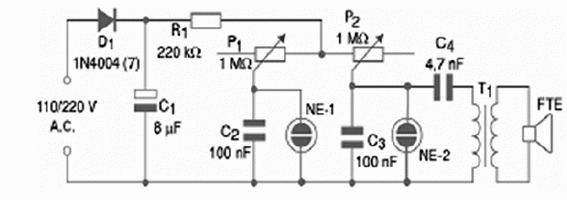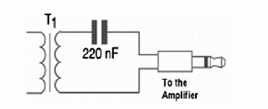This project is recommended to high school and technical courses students, since it works with high voltages. Figure 1 shows a very simple experimental circuit based in neon lamp relaxation oscillators. This circuit can generate an audio signal that sounds like a two tone siren when amplified and reproduced by a loudspeaker. The circuit must be powered by a 10 to 100 V DC power supply. This project is part of my book Science Fair and Technology Education Projects published in USA.

The circuit uses a low frequency oscillator modulating a tone generator, both based in neon lamp relaxation circuits. The modulation introduces frequency changes in the tone, imitating a siren.
The final transducer in this circuit is a small loudspeaker, without any amplification, but the output can be plugged to a powerful amplifier for a loud sound reproduction .This can be made as figure 2 shows.

As you can see, this circuit is plugged directly to the AC power line, so any of its points should not be touched when in operation, with the risk of dangerous shocks.
Any transformer with a primary of 110 or 220 V and secondary of 6 to 12 V and current rates up to 500 mA, can be tested. The performance will depend on this component. The capacitors determine the modulation and the sound frequency and can be changed by others in a large range of values.
Since it is an experimental project, we suggest the use of a terminal strip to place the components. Only the small transformer is mounted on a wooden or plastic base with terminals.
This transformer is prepared this way to be used in other projects and experiments. C1 must have a WVDC (Working Voltage DC) of 200 V or more, if you are plugging the device to the 110/117/127 AC power line, and 400 V or more, if the device is powered by the 220/240 V AC power line.
Adjust the tone and modulation rate by turning the knob of P1 and P2. These are common linear or logarithmic Potentiometers. Be careful with the position of the diode and the electrolytic capacitor. Any inversion can be dangerous, burning components.
Challenge
- Create the best alarm system using this siren.
- Find applications to the circuit.
D1—1N4004 (110/117/127 AC power line) or 1N4007 (220/240 V AC power line) - silicon rectifier diode
NE-1, NE-2 - Common neon lamps
C1—8 ?F x 200 (400 V) - electrolytic capacitor
C2—100 nF x 200 V—polyester capacitor
C3 - 10 nF x 200 V - polyester capacitor
C4—4.7 nF x 100 V—polyester capacitor
R1—220 k? x 1/8 W—resistor (red, red, yellow)
P1, P2—1 M?—lin or log Potentiometers
T1—Transformer—see previous text
FTE—4 to 16 ?—small loudspeaker
Other:
Terminal strip, power cable, knobs for the Potentiometers, wires, solder, etc.



